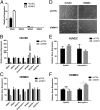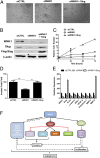Actions of the protein kinase WNK1 on endothelial cells are differentially mediated by its substrate kinases OSR1 and SPAK
- PMID: 25362046
- PMCID: PMC4234555
- DOI: 10.1073/pnas.1419057111
Actions of the protein kinase WNK1 on endothelial cells are differentially mediated by its substrate kinases OSR1 and SPAK
Abstract
The with no lysine (K) (WNK) family of enzymes is best known for control of blood pressure through regulation of the function and membrane localization of ion cotransporters. In mice, global as well as endothelial-specific WNK1 gene disruption results in embryonic lethality due to angiogenic and cardiovascular defects. WNK1(-/-) embryos can be rescued by endothelial-specific expression of a constitutively active form of the WNK1 substrate protein kinase OSR1 (oxidative stress responsive 1). Using human umbilical vein endothelial cells (HUVECs), we explored mechanisms underlying the requirement of WNK1-OSR1 signaling for vascular development. WNK1 is required for cord formation in HUVECs, but the actions of the two major WNK1 effectors, OSR1 and its close relative SPAK (STE20/SPS1-related proline-, alanine-rich kinase), are distinct. SPAK is important for endothelial cell proliferation, whereas OSR1 is required for HUVEC chemotaxis and invasion. We also identified the zinc-finger transcription factor Slug in WNK1-mediated control of endothelial functions. Our study identifies a separation of functions for the WNK1-activated protein kinases OSR1 and SPAK in mediating proliferation, invasion, and gene expression in endothelial cells and an unanticipated link between WNK1 and Slug that is important for angiogenesis.
Keywords: EMT; Slug; angiogenesis; endothelium; migration.
Conflict of interest statement
The authors declare no conflict of interest.
Figures





References
-
- Xu B, et al. WNK1, a novel mammalian serine/threonine protein kinase lacking the catalytic lysine in subdomain II. J Biol Chem. 2000;275(22):16795–16801. - PubMed
-
- Min X, Lee BH, Cobb MH, Goldsmith EJ. Crystal structure of the kinase domain of WNK1, a kinase that causes a hereditary form of hypertension. Structure. 2004;12(7):1303–1311. - PubMed
Publication types
MeSH terms
Substances
Grants and funding
LinkOut - more resources
Full Text Sources
Other Literature Sources
Molecular Biology Databases
Research Materials

